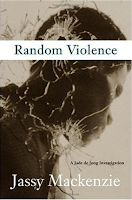

In 1929, Upfield (photo left) was a government boundary rider on the Number One Rabbit Fence in Western Australia, based at the Camel Station. He was working on his next Napoleon Bonaparte mystery, The Sands of Windee and stuck on how to completely dispose of a body to commit the perfect crime. One night over a game of poker, Upfield asked George Ritchie, who lived at the station, how he would go about it. Ritchie gave Upfield a method without hesitation. Upfield thought the plan brilliant and decided to incorporate into the story. This was Ritchie's plan:
1. Burn the body, including clothing.
2. Shift through the ashes, remove any bone fragments, metal (like shoe eyelets), etc.
3. Crush remaining bone to powder, dispose of the other items down a well.
3. Burn the carcase of a couple of kangaroos on the same site to disguise the purpose of the fire.
Burning kangaroo carcases would not have been unusual in Australia at the time. Besides the problem of pollution, it was important to avoid fly infestations that would affect the sheep.
The topic was much discussed and a likable fellow by the name of Snowy Rowles (photo above right) was present at the discussions. Later, after Snowy had left the area, three men disappeared -- James Ryan, George Lloyd, and Lois Carron -- and Snowy became the lead suspect since all three were last seen in his company. Snowy tried to follow the Upfield's plot device but failed to follow the plan completely and left evidence behind.
The word
Murchison in the title refers to the area in Western Australia where the crimes occurred.
The Murchison Murders is a true crime that should be of interest to devoted crime fiction readers. First, here is a case where life attempts to imitate fiction. An author has the perfect crime for his novel and someone tries to make it work. Upfield was one of the witnesses at Snowy's trial, testifying that Snowy was present when the perfect crime was discussed.
Second, the description of the investigation itself is fascinating as an example of police procedures in a challenging setting. While the methods are the same, the investigation is a testament to the thoroughness of Detective-Sergeant Harry Manning who put the case together. Consider that this is Australia in 1930s, communications are limited, distances are great. Adding to the challenges, one of the victims, Louis Carron, came from New Zeland which figured into the investigation.
To put together a time-line, Manning traveled to every place the three men were supposed to have been before they disappeared and interviewed everyone who might have come in contact with them. He reviewed hotel registers and store ledgers.
Rowles made several mistakes: he changed his story several times arousing suspicion; he kept some of the belongings of the murdered men; and he failed to remove incriminating items from the site where he burned Louis Carron. Among the items found at the site were parts of a skull, a tooth with a cavity, a wedding ring, some odd wire stitching, and gold clips from a dental plate.
Writing to Carron's wife in New Zeland, Manning was able to find his dentist and the jeweler where the wedding ring was inexpertly repaired. As the repair involved using two different grades of gold, he was able to identify the ring as having belonged to Carron. The dentist was also able to identify the tooth and plate clips as being consistent with the work he did on Carron.
When Rowles was apprehended Manning found the truck owned by one of the missing men, Ryan,and two watches. With the marks on the watches, he found the Perth jewelers who had repaired the watches and returned them to Carron in boxes with the odd stitching found in the ashes. More damning, Rowles himself sent the watches for repair and those repairs were performed by the same jewelers.
The case against Rowles was tight and he was found guilty and hanged. Despite pleas to tell what happened to James Ryan and George Lloyd, Rowles never admitted to any crime, even when his death was assured, and went to the noose claiming innocence.
This small book includes three additional chapters: "Patrolling the World's Longest Fence"; "An Australian Camel Station"; and "Trapping for Fur". These chapters do not relate directly to the murders but are interesting to a modern reader because the help give a picture of what the Australian bush and outback were like when Upfield was writing his Napoleon Bonaparte stories.
Upfield writes non-fiction with his usual florid and awkward sentence constructions. He was fond of starting a sentence with a prepositional phrase:
At the Camel Station lived George Ritchie. To the Camel Station once every month came two Government boundary riders.
Upfield is an entertaining writer, style notwithstanding, and is interesting to me for the way of life he captures in his works.







